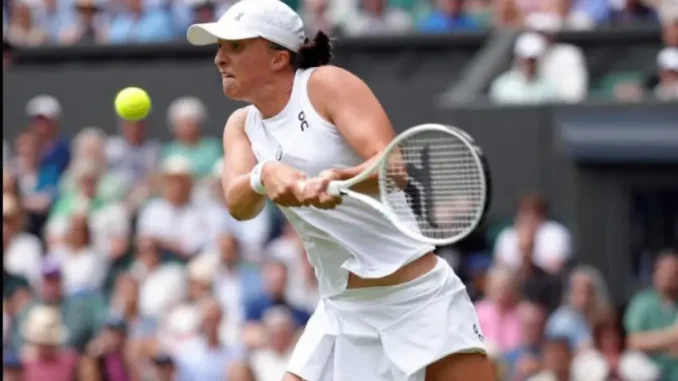
As the tennis world turns its gaze to the emerald courts of Wimbledon, Iga Swiatek, the five-time Grand Slam champion, stands at a crossroads in her grass-court journey. The 24-year-old Pole, a clay-court titan, has yet to conquer the slippery, unpredictable surface that defines the All England Club. Enter Andy Roddick, the former world No. 1 and three-time Wimbledon finalist, who has offered Swiatek a blueprint for success on grass. His advice, described as “effective” and straightforward, centers on a tactical shift that could unlock her potential at the 2025 Championships. “Specifically to Iga on grass, I’d like to see her take more balls on her backhand side and not try to do that little circle to hit the inside-out forehand as much,” Roddick said, setting the stage for a pivotal moment in Swiatek’s career.
Swiatek, currently ranked world No. 8, kicked off her grass season at the Bad Homburg Open, a WTA 500 event in Germany, where she faced Victoria Azarenka in the second round after a first-round bye. Her 6-4, 6-4 victory over the two-time Grand Slam champion marked a promising start, but grass remains her least mastered surface. With only one Wimbledon quarter-final appearance in 2023 and a shocking third-round exit to Yulia Putintseva last year, Swiatek’s grass-court record stands in stark contrast to her dominance on clay, where she has claimed four French Open titles. Roddick, speaking on the Tennis Channel Live podcast, pinpointed a key flaw in her grass game: her reliance on her forehand. “What makes her a superhero as far as RPMs and getting the ball up and away and pulling people off the court becomes a bit of a liability, especially if she has to run to hit it,” he explained, noting that her high-spin forehand often sits up on grass, inviting aggressive returns.
Roddick’s solution is elegantly simple: lean into her backhand. “The simplest adjustment we can make is let’s take a lot more backhands,” he advised, emphasizing that her backhand, when struck from the center or left of the court, penetrates the grass more effectively. This tactical tweak could neutralize opponents who target her forehand, exploiting the low bounce and fast pace of grass. He also urged Swiatek to vary her second serve, suggesting she “run them into the bodies a little bit more” to disrupt returners’ rhythm and prevent clean hits. These adjustments, Roddick believes, could transform Swiatek from a grass-court underdog into a genuine contender at Wimbledon, which begins on June 30.
Swiatek’s 2025 season has been a tale of resilience amid adversity. After a title-less run since her 2024 French Open triumph, she has faced relentless scrutiny from Polish media, a pressure Roddick has vocally criticized. “If you’re a sports journalist in Poland and you are crushing Iga on a week-to-week basis, you’re a f****** moron,” he said on his Served podcast, defending her status as Poland’s greatest sporting icon. Her recent dip in form, including semi-final losses at the Australian Open and Madrid Open, has fueled doubts, but her Bad Homburg performance hints at a revival. Facing potential quarter-final clashes with Ekaterina Alexandrova or Maria Sakkari, Swiatek is testing Roddick’s advice in real time, aiming to build momentum before Wimbledon.
Roddick’s insights carry the weight of experience. A grass-court specialist who reached Wimbledon finals in 2004, 2005, and 2009, he understands the surface’s demands. His own game, built on a booming serve and aggressive play, thrived on grass, though he fell to Roger Federer in each final. His admiration for Swiatek is evident—he’s described her clay-court movement as so efficient it makes him “vomit with jealousy”—but he sees untapped potential on grass. By contrast, Swiatek’s current approach, with its clay-centric spin and footwork, struggles to adapt to grass’s low, skidding balls. Roddick’s call for more backhands and strategic serving offers a path to overcome these challenges.
As Swiatek prepares for Wimbledon, where she’s seeded eighth, her determination to master grass is clear. “I really want to learn how to play on grass better. Every year is another opportunity,” she said, dismissing rumors of skipping the tournament. With Roddick’s advice as a guide, she faces a field led by Aryna Sabalenka, Elena Rybakina, and Coco Gauff, all of whom Roddick considers stronger grass-court threats. Yet, Swiatek’s ability to adapt could surprise. Her Bad Homburg campaign, coupled with Roddick’s tactical wisdom, sets the stage for a defining moment. Will she harness her backhand and serve to silence doubters at SW19? The tennis world watches, eager for the next chapter in Iga Swiatek’s remarkable story.
Leave a Reply